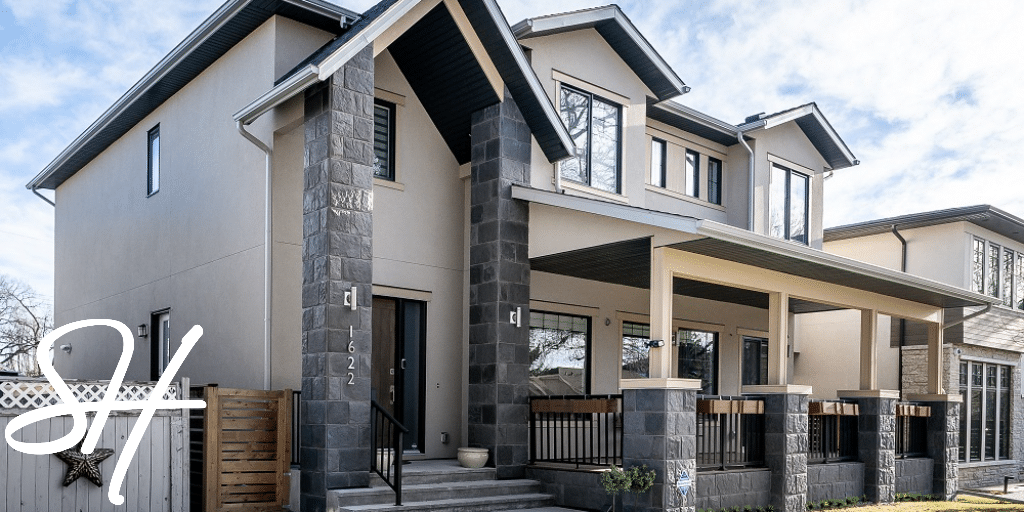
The construction industry, by its very nature, is a big user of natural resources. But with growing concerns over climate change and the finite nature of these resources, there is growing pressure on construction firms to reduce their environmental impact. While there are challenges involved for Calgary custom home builders in adopting sustainable construction methods, there are also great benefits too. What are the key questions we should be asking in terms of sustainable home construction?
Is Sustainable Home Construction Worth It?
Putting your building project up to these aggressive standards might sound difficult, but the sustainability factor is worth it. With a Calgary custom home builder providing an airtight home and innovative heating and cooling techniques, you’ll find yourself using less energy and reducing your carbon load.
How Do I Keep to my Budget and Build a Sustainable Custom Home?
Self-built homes come in all manner of shapes, sizes, and specifications. This is because they have been designed and built to meet the individual needs and tastes of those who live in them. It is difficult for prospective self-builders to get a handle on what kind of home they could build on their budget due to the variety and broad variance in build costs
Every stage requires the rigorous monitoring of costs and it is important to keep on top of this. It’s not enough to establish a detailed budget. The ability to track it and strictly protect it will be hugely beneficial in the long-run. You need to comply with your budget and respect it when the expenses mount up throughout construction and renovation. To avoid a budget failure before you’ve even begun it is best to choose a general contractor before beginning the design, and involve them in the process. This will help you evaluate costs from the first conceptual drawings and during all the stages of the design.
Choosing a contractor should be based on their reputation and competence, and not on the cheapest quote available. Utilizing a Calgary infill home builders company during the design phase is smart instead of waiting until plans are completed. This will save you time and money. A contractor mandated to ensure compliance with your budget bears a real responsibility when he delivers estimates because they are obligated to build to completion based on the prices originally quoted. In contrast, you will have to pay a designer’s fees even if the design cannot feasibly be completed within your allotted budget.
What Certifications are Available if I Decide to Build a Sustainable Custom Home?
There are currently hundreds of sustainability certifications for the built environment and the number is set to rise as the focus on certifying buildings continues to increase;
BuiltGreen – Built Green Canada is a national certification program focused on residential building. This includes single-family homes and high-density buildings as well as renovations. In their assessments, Built Green accounts for: energy and envelope, materials and methods, indoor air quality, ventilation, waste management, water conservation, and building practices.
EnerGuide – This simple 0 to 100 rating system, backed by Natural Resources Canada (NRCan), measures a home’s energy performance only, so it’s specifically for users wanting to focus on this particular aspect of a home’s construction, or for those considering energy performance in their renovation and upgrade projects. EnerGuide homes have had their plans evaluated by a certified energy advisor. Energuide evaluations provide homeowners with “a government-backed energy efficiency rating and label” for their homes.
ENERGY STAR® for New Homes – ENERGY STAR® for New Homes is also backed by NRCan. The label ensures homes are performance-tested, third-party verified and government-backed. ENERGY STAR® homes’ energy efficiency improvements are mostly hidden—better insulation, high-performance windows, tighter air sealing—but very effective at improving home performance.
Green Globes – This assessment and rating system is administered by GB Initiative Canada. It covers new construction as well as renovation projects and is used on a wide variety of commercial and public building types. Green Globes is an online, interactive tool with automated reporting that significantly reduces the time and cost of submissions. This is an in-home self-assessment tool, wherein users, in consultation with their project managers and design teams, submit answers about construction choices through an online questionnaire. The project is awarded points, but the system also offers practical guidance and strategies. The project input can be changed as often as desired before verification.
LEED – LEED (Leadership in Energy and Environmental Design) is an internationally recognized third-party certification program for buildings and homes. It’s administered in Canada by the Canada Green Building Council (CaGBC). LEED accounts for sustainability in five areas: location and transportation, sustainable site development, water savings, energy efficiency, materials selection and indoor environmental quality. Ratings of certified, silver, gold or platinum are awarded according to a comprehensive 100-point rating system. LEED offers a few different rating systems, each of which includes requirements as well as optional credits that can be used towards certification.
How Can I Reduce Carbon and GHG emissions and at the Same Time Increase My Use of Renewable Energies?
Offsetting Your Carbon Emissions
Offsetting the amount which you are not able to avoid empowers you to take full responsibility for your carbon pollution, which is your contribution to climate change. Carbon offsetting is not a replacement for taking measures to reduce one’s carbon emissions. Carbon offsetting and carbon emissions reduction should be done together to maximize the impact you make. Measuring your carbon emissions not only reveals your current position but also helps to detect areas for improvement and measure your progress.
Usage of water
Lower the amount of energy used to pump, treat, and heat water by washing your car less often and using climate-appropriate plants in your garden. Install drip irrigation in your garden and make water-efficient choices when purchasing showerheads, faucet heads, toilets, dishwashers, and washing machines.
Recycle after reuse
Large proportions of greenhouse gas emissions result from the extraction of resources, manufacturing, transport, and final disposal of goods which include consumer products and packaging, building components, and passenger vehicles. By buying used products and reselling or recycling items you no longer use, you dramatically reduce your carbon emissions from the aforementioned subjects.
Supporting clean energy sources
Wherever possible and at every opportunity choose clean alternatives to fossil fuels, such as wind, solar, geothermal, and appropriately designed hydroelectric and biomass energy projects.Sustainable home construction for Calgary inner city builders is not just about the future but about the here and now. Therefore, understanding what it’s all about will help you to understand just how important it truly is.
If you are considering building a sustainable home contact Sunset Homes today.
Learn more about our Calgary custom homes and major renovations and follow our progress on Facebook, Instagram, and Houzz!
Too Long Didn’t Read (TLDR)
There are four essential questions to consider when embarking on sustainable home construction. Is sustainable home construction worth it? How do I keep to my budget and build a sustainable custom home? What certifications are available if decide to build a sustainable custom home? How can I reduce carbon and GHG emissions and at the same time increase my use of renewable energies?
